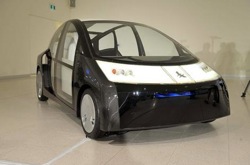In little more than a decade, you could be driving a Toyota made from seaweed. That’s a tantalising vision of motoring in the 2020s if the Japanese car maker’s engineers get their way. Toyota’s engineers are trying to plot a course for the post-oil age, and plastics for structures and trim made from plants could be used to make cars of the future, says the manager of Toyota’s Australian styling studio, Paul Beranger.
 This Toyota concept car is made from carbon fibre. This Toyota concept car is made from carbon fibre.In the future it could be made with plastics produced from seaweed. |
For now, Mr Beranger and his designers have focused on localising the look of the much-heralded petrol-electric hybrid Camry, which will be displayed in “concept” form at Friday’s motor show opening in Melbourne. The “concept” version to be shown features show-car bling – such as fancy blue headlights, a pearlescent paint job and a nature-inspired randomly patterned grille – to dress up what is otherwise a fairly standard-looking Camry.
The hybrid Camry, approved for local production from early next year with federal and state government grants totalling $50million, has not been without its controversy. In effect, taxpayers are helping to fund the hybrid Camry twice: once to be built, and again when bought by government fleets.
Toyota Australia’s senior executive director of of sales and marketing, David Buttner, defended the decision to build the car with the help of government grants. “It’s important … to see an environment that’s conducive to investment,” he said. “The government money was certainly instrumental in enabling us to be the third base (outside Japan) for this vehicle.”
Mr Buttner said the company would build about 10,000 hybrid Camrys at Altona and that initially the foreign content (consisting of the hybrid drive train, which will be imported) would remain high. “While we’re establishing the product here in Australia, there will be a significant import content, both of the engine and of the (transmission) but over time … we’re always striving to do things locally,” he said.
He described as “disappointing” criticism that the hybrid Camry brings little innovation to the local industry. “This technology is designed to ensure we have sustainable mobility and we will only have sustainable mobility if this type of technology grows,” he said. “It will be the first of this type of technology built in Australia.” Over time, local suppliers would be involved in the hybrid drive train. “It’s a very important thing, not just for Toyota in Australia but for the auto manufacturing sector in Australia.”
The most futuristic car on Toyota’s stand will be the “1/X” that uses lightweight carbon fibre for its chassis, cutting weight to about one-third of a similarly sized compact car. The low weight allows for a 500cc engine. It is this type of low-weight vehicle that Japanese engineers will seek to make from plant-derived eco-plastics. Mr Beranger said seaweed was plentiful in Japan and made a natural choice for plant-fibre plastics. Plant plastic, made from ramie and kenaf, are already used on the new, third-generation hybrid Prius, which will also be exhibited. The motor show at the Melbourne Convention and Exhibition Centre opens to the public on Friday afternoon.
Source
The Sydney Morning Herald, 2009-02-24.
Supplier
Share
Renewable Carbon News – Daily Newsletter
Subscribe to our daily email newsletter – the world's leading newsletter on renewable materials and chemicals










